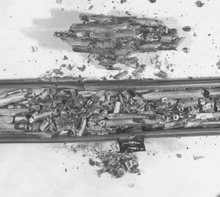The following text in italics is copied from the transcript of the full ACRS meeting on February 1, 2007. It is a very small part of the part of the transcript that covers TRACE, however, it reveals more than the previous lengthy discussion of the TRACE activities.
MEMBER ABDEL-KHALIK: But philosophically, if you had a perfect code, and you understand the physics, then it doesn't matter what the scale is because you're verifying phenomena. And therefore, by this process, you're essentially saying the code is nothing more than an empirical fitting tool for the experimental data. Is that true?
MEMBER BANERJEE: It cannot predict new phenomena.
MEMBER ABDEL-KHALIK: Because you are limiting the range of applicability of the code, essentially, to a rather narrow range around where the experiment is. So the code, you philosophically by doing this, you're viewing the code as nothing more than an empirical fitting tool.
MR. BAJOREK: I think that's an accurate statement.
MEMBER POWERS: Do you really want to say that though? I think that's what he was getting at.
MEMBER BANERJEE: It's not predictive of new phenomena.
MR. BAJOREK: That's the -- these codes are not based on first principles. They are based on and held together by closure relations which are based on sub-scale experiments. A lot of those correlations come from single tube tests and you are using that at faith when you start to look at larger and larger scales. Assessment helps to benchmark and let you know whether those correlations are truly applicable with those other conditions but going back to the experiments, we all in integral tests in particular, you want to try to establish a basis for that system global-wide behavior and is it going to behave much like you'd expect in something with much larger scale. But the smaller scale test, that's all you have to run the full test.
MEMBER BANERJEE: As we come to full scale tests.
MR. BAJOREK: If we had full scale tests the --
MEMBER BANERJEE: The assemble system, we can do it in components.
MR. BAJOREK: Components, yes. That's all
The complete transcript from which the above was extracted may be found at:
http://www.nrc.gov/reading-rm/doc-collections/acrs/tr/fullcommittee/2007/ac020107.pdf
However, all of the single tube tests, and also the larger scale tests were conducted with clean (unfouled) heat transfer surfaces. Faith in those tests is blind faith. More later on this.
Subscribe to:
Post Comments (Atom)

1 comment:
ok i just want to leave a statement for all of your posts- I really enjoy your common sense and experience filtering through here! I miss the reality of machine-shop vs. academia and "faith" as you say in these codes from correlations where we aren't taught where the tests and data came from in the first place. It seems my generation is taking by faith that these worked as a fundamental principle rather than as the rule of thumb from the generations that KNEW how many variables we didn't know and that there is uncertainty in manufacturing and management that maybe shouldn't be quantified as we have done today.
Post a Comment